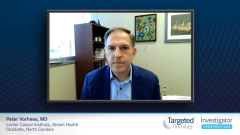
Addressing Transplant-Ineligible Newly Diagnosed Multiple Myeloma
Expert insight on the optimal management of transplant-ineligible newly diagnosed multiple myeloma in light of available therapies and clinical data.
Episodes in this series

Transcript:
Peter Voorhees, MD: What available frontline treatments can be used for transplant-ineligible patients? We have several. The 1 used most commonly in the United States is the combination of RVD, or lenalidomide, bortezomib, and dexamethasone. For those patients who are truly transplant ineligible, perhaps as a result of increased frailty, the RVD [lenalidomide, bortezomib, dexamethasone]–lite regimen or some iteration of that is commonly used in these patients. We have newer data supporting the role of the CD38 monoclonal antibody—daratumumab in combination with lenalidomide and dexamethasone—for patients with newly diagnosed myeloma who are not undergoing the initial transplant. In some instances, if the patient does not have significant cardiovascular risk factors, the carfilzomib, lenalidomide, and dexamethasone triplet can also be used. In select instances, we may use the cyclophosphamide-bortezomib-dexamethasone regimen. For example, let’s say a patient newly diagnosed in the hospital with acute renal failure Given the increasing body of literature supporting proteasome inhibitor triplets in this patient population, we will typically transition those patients to a PI [proteasome inhibitor]–IMiD [immunomodulatory imide drug] or CD38-IMiD-dexamethasone triplet on the outpatient side of things. Increasingly the literature supports that the doublet regimens are inferior to the triplet regimens and should be used only in exceptional circumstances.
What’s my approach to treatment duration, and why? As I explain to patients and to community oncologists: when in Rome, do what the Romans do. If you want to recapitulate the results we’re seeing in randomized trials that inform practice for multiple myeloma, do what they did in the trials, as long as you can do it in a way that’s tolerable for patients. For example, going back to the RVD [lenalidomide, bortezomib, dexamethasone] regimen in the transplant-ineligible patients, the SWOG-S0777 study utilized the triplet for 24 weeks, or eight 3-week cycles followed by lenalidomide maintenance. That’s what I’ll do in that circumstance. And just like what was done in the protocol, I’ll treat until disease progression or the emergence of unacceptable adverse effects that I can’t manage by dose reductions or supportive care. Similarly, with the daratumumab-lenalidomide-dexamethasone triplet in patients with transplant-ineligible myeloma, the way that study was designed is patients were either assigned to the lenalidomide-dexamethasone doublet or daratumumab-lenalidomide-dexamethasone triplet until disease progression or the emergence of unacceptable adverse effects. My intent is to continue to treat patients until their disease has developed resistance to that regimen or they’ve developed unacceptable adverse effects that I’m not able to manage with those reductions and optimal supportive care.
What do I do if a patient requests a drug holiday, or doesn’t want to resume treatment after an adverse effect? Patient preference is critical and has to be first in any decision-making that occurs. In that circumstance, I’ll try to better understand the particular adverse effect. What have we done to manage it? How severe is it? Are there any other strategies up our sleeves that can mitigate that adverse effect that’s leading to the patient wanting to come off therapy? If the answer is yes, then I’ll work with the patient to try and achieve that goal. If an adverse effect has had a significant impact on quality of life, despite optimal supportive care and modifications to the regimen, then in that circumstance it’s absolutely appropriate to hold therapy. If the patient requests a drug holiday in the absence of unacceptable adverse effects, then it’s a discussion. You have to help them understand that the success of these regimens that we were using was in the context of treatment until disease progression. They have to understand that a drug holiday could potentially impact the effectiveness of the regimen in the long term. I always tell patients that duration of remission for that first treatment is absolutely critical. With all the advances occurring in myeloma right now, with the standard of care for both newly diagnosed and relapsed disease changing at lightning pace, the longer you’re in remission that first time around, the more opportunities you’ll have at the time of relapse.
Transcript edited for clarity.









































